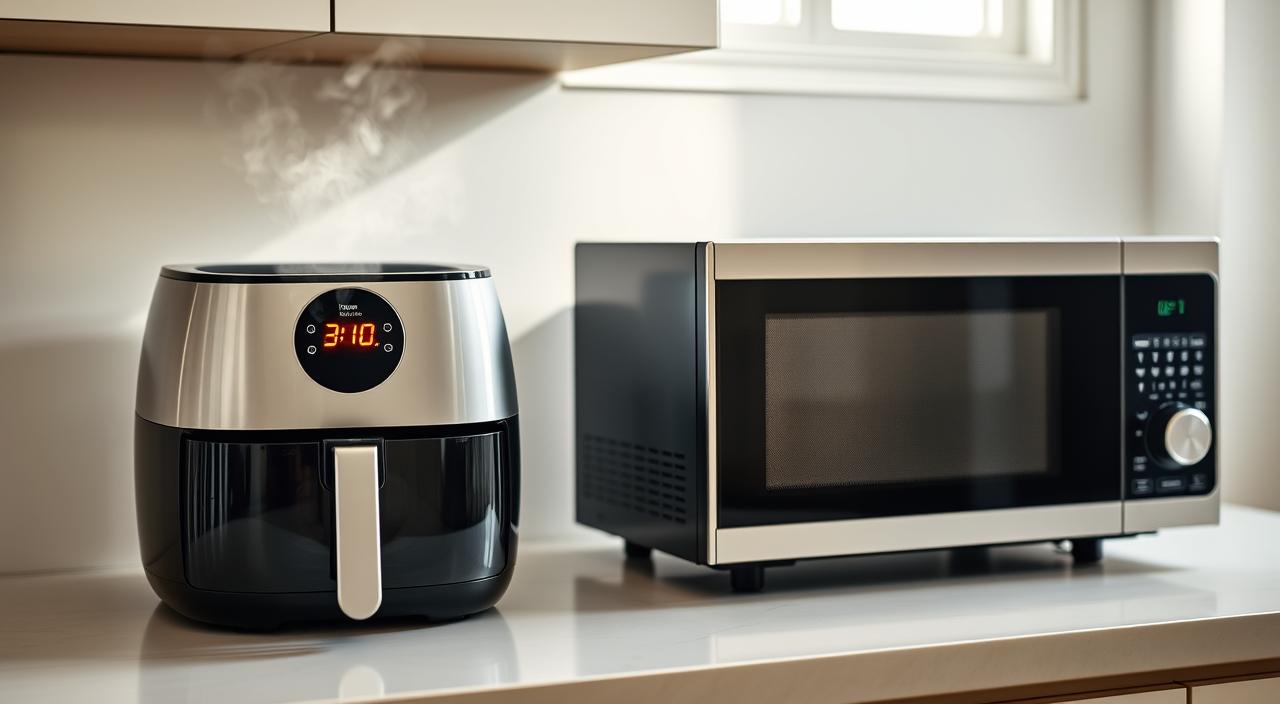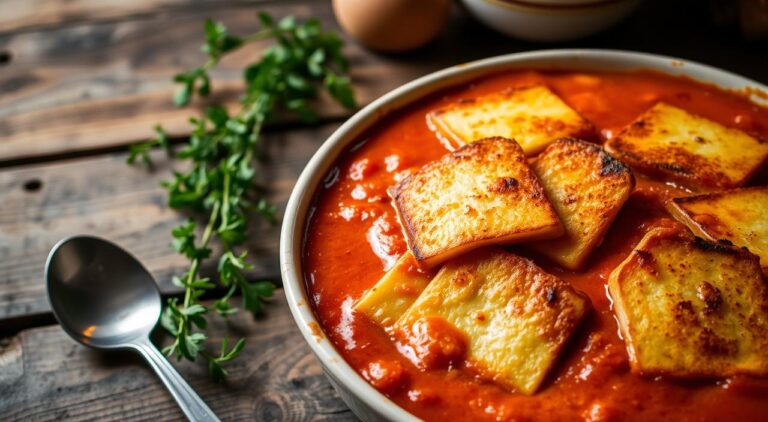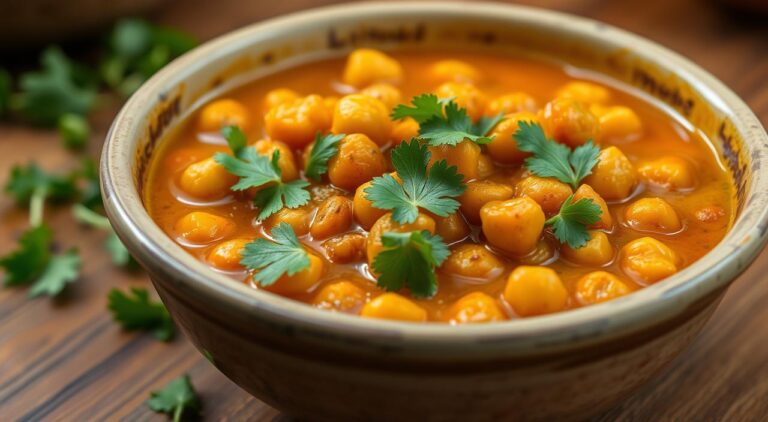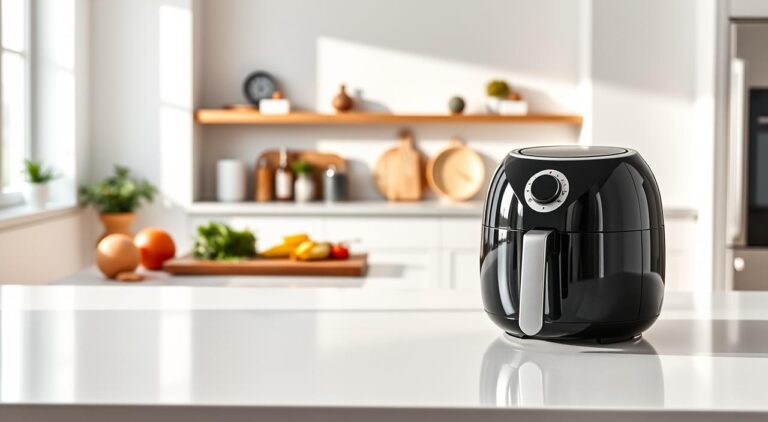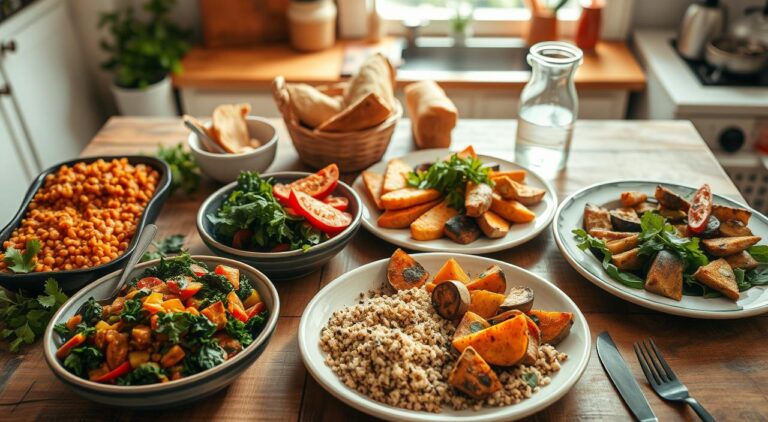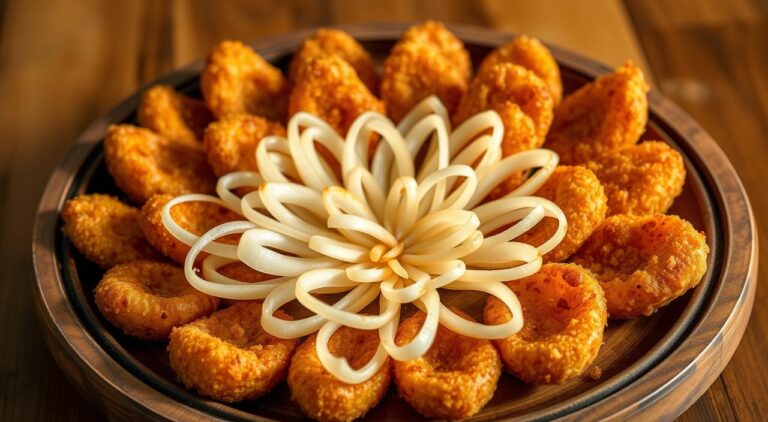Air Fryer vs. Microwave: Which Cooks Faster?
In today’s kitchens, cooking speed and efficiency are key. Air fryers and microwaves have changed how we cook. They make meals quicker and easier to prepare.
Many people wonder which one is faster: air fryers or microwaves. This article will compare them. It will help you choose the right one for your cooking needs.
Key Takeaways
- Air fryers and microwaves serve different cooking purposes.
- Cooking speed varies based on the type of food being prepared.
- Understanding the strengths of each appliance is crucial for efficient meal prep.
- The comparison will highlight the unique benefits of each.
- Your cooking needs will determine which appliance is faster.
Understanding Air Fryers
Air frying uses hot air to make food crispy on the outside and tender inside. It’s a healthier way to enjoy fried foods without too much oil.
What is an Air Fryer?
An air fryer cooks food by circulating hot air around it. This method makes food crispy like deep-frying but uses less oil. You can cook many dishes in an air fryer, from fries to roasted veggies to know more about air fryer check our 5 Air Fryer Hacks You Need.
Key Features of Air Fryers
Air fryers have features that make cooking easy and efficient. These include:
- Digital Controls: You can set the temperature and timer precisely with digital controls.
- Non-Stick Basket: The basket is non-stick, making food easy to remove and cleaning simple.
- Multiple Cooking Settings: Some models have preset settings for different foods, ensuring perfect cooking.
Consumer Reports notes, “Air fryers are popular for a healthier fried food option.” This shows people want healthier cooking choices.
Benefits of Using an Air Fryer
Using an air fryer has many benefits. They offer a healthier option than deep-frying and are easy to use and clean. Here are some key benefits:
| Benefit | Description |
|---|---|
| Healthier Cooking | Air fryers use much less oil than deep-frying. |
| Ease of Use | Most air fryers have simple controls and preset settings for various foods. |
| Versatility | Air fryers are not just for frying; they can grill, roast, and bake too. |
Cooking expert Mark Bittman says, “Air fryers are great for cooking many dishes with little effort and cleanup.” This highlights their convenience and versatility in cooking.
Understanding Microwaves
The microwave oven is a common kitchen tool. It uses electromagnetic waves to heat food quickly and evenly. This makes microwaves great for reheating leftovers, defrosting frozen foods, and cooking some meals.
What is a Microwave?
A microwave oven heats food with electromagnetic waves, called microwaves. When you press start, it sends waves into the food. These waves make the water molecules in the food vibrate fast, creating heat.
Key Features of Microwaves
Microwaves have features that make them useful. Some key features include:
- Variable Power Levels: This lets you adjust the power for different foods.
- Sensor Cooking: It adjusts cooking time based on the food’s moisture, ensuring perfect cooking.
- Quick Defrost: It defrosts frozen foods quickly, reducing bacterial growth risk.
Benefits of Using a Microwave
Microwaves have many benefits for your kitchen. The main advantages are:
- Speed: They cook and reheat food much faster than other methods.
- Convenience: They are easy to use, with simple controls and quick cooking times.
- Energy Efficiency: Microwaves use less energy than traditional ovens, saving on bills.
In comparing kitchen appliances, microwaves are unique. They quickly cook and reheat food. Knowing how microwaves work and their benefits helps you choose the right appliances for your kitchen.
Cooking Times: Air Fryer vs. Microwave
Air fryers and microwaves cook food at different speeds. The exact time depends on the food and the appliance model.
Cooking Times for Air Fryers
Air fryers cook food longer than microwaves. For example, french fries take 15-20 minutes, and chicken breasts need 20-25 minutes. But, air fryers make food crispy, unlike microwaves.
Typical Cooking Times:
- French Fries: 15-20 minutes
- Chicken Breasts: 20-25 minutes
- Steak: 10-15 minutes
Cooking Times for Microwaves
Microwaves cook food quickly. Reheating leftovers takes 1-2 minutes, and frozen veggies cook in 3-5 minutes. But, microwaves can cook unevenly and make food soft.
Typical Cooking Times:
- Reheating Leftovers: 1-2 minutes
- Frozen Vegetables: 3-5 minutes
- Cooking Frozen Meals: 5-7 minutes
Let’s compare cooking times for air fryers and microwaves with a table for common foods.
| Food Item | Air Fryer Cooking Time | Microwave Cooking Time |
|---|---|---|
| French Fries | 15-20 minutes | 5-7 minutes |
| Chicken Breasts | 20-25 minutes | 8-10 minutes |
| Reheating Leftovers | 5-7 minutes | 1-2 minutes |
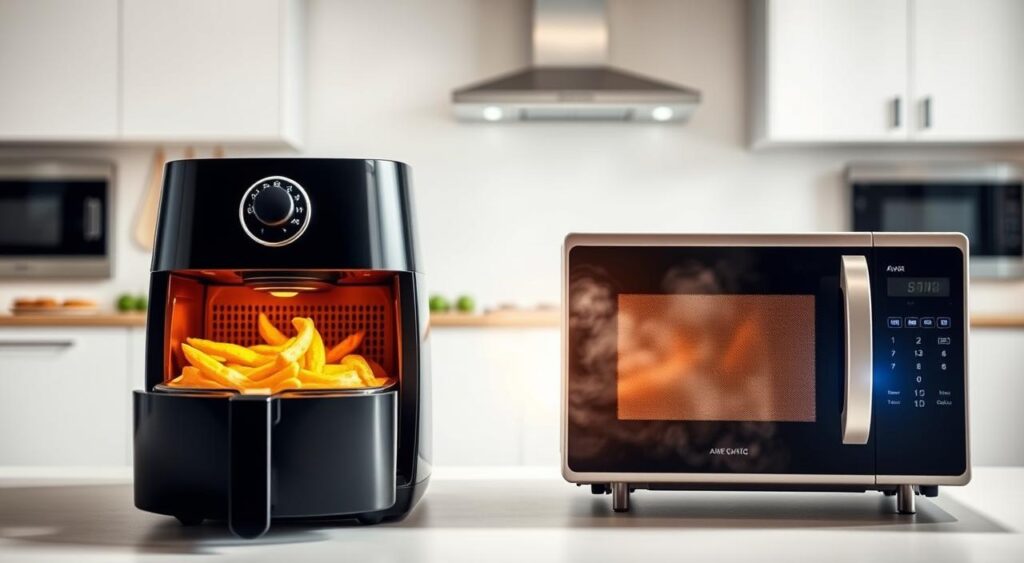
Efficiency of Each Appliance
Air fryers and microwaves cook food differently, affecting their energy use. It’s key to look at how much energy each uses.
Energy Consumption of Air Fryers
Air fryers need a lot of energy to cook food. They use 800-1500 watts, depending on the model and settings. They cook food faster than ovens but use a lot of energy.
Cooking fries in an air fryer takes 15-20 minutes. It uses about 0.3-0.5 kWh of electricity. It’s important to compare this to other cooking methods.
Energy Consumption of Microwaves
Microwaves are more energy-efficient, great for quick reheats. They use non-ionizing radiation, needing less energy than traditional methods. A microwave uses 600-1200 watts of power.
Reheating food in a microwave takes 1-3 minutes. It uses about 0.01-0.06 kWh of electricity. This makes microwaves good for saving energy when reheating.
Comparing air fryers and microwaves, microwaves win for quick reheats. But air fryers might be better for frying foods than deep-frying.
Food Quality and Texture
The texture and quality of food are key when choosing how to cook. It’s important to know how air fryers and microwaves affect food differently.
How Air Fryers Improve Texture
Air fryers make food crispy, like fried foods but with less oil. They use fast air circulation to dry the food’s surface. This makes the outside crunchy and the inside tender.
For example, air-fried French fries are crispy on the outside and fluffy inside. It’s like deep-frying but with much less oil.
Crispy textures aren’t just for fries. Air fryers can make chicken wings and veggies crispy too. This makes them taste better and look more appealing.
Microwave Cooking vs. Texture
Microwaves can make food unevenly heated and soft. This is because they heat food by making water molecules vibrate. This can lead to overcooking in some spots and undercooking in others.
But microwaves aren’t all bad for texture. They’re good for steaming veggies, keeping them crunchy and colorful if cooked right. It’s all about knowing the right cooking times and power levels.
Choosing between an air fryer and a microwave depends on the food and the texture you want. Air fryers are best for crispy foods. Microwaves are quicker for reheating or steaming.
Versatility in Cooking
Cooking appliances like air fryers and microwaves change how we prepare meals. They are popular for their many uses in the kitchen. This makes them essential for today’s cooks.
Cooking Options with an Air Fryer
Air fryers are great for cooking many dishes, from fried foods to baked goods, with less oil. They are loved by those who care about health and like trying new recipes.
- Frying: Get crispy fried foods with little oil.
- Baking: Bake cakes, cookies, and desserts.
- Grilling: Grill meats and veggies perfectly.
- Roasting: Roast dishes like meats and veggies.
Key Benefit: They can do many cooking tasks in one.
Cooking Options with a Microwave
Microwaves are not just for reheating leftovers. They can also steam veggies and cook some proteins.
- Reheating: Quickly reheat leftovers.
- Cooking: Cook proteins and veggies.
- Steaming: Steam veggies to keep nutrients.
- Defrosting: Defrost frozen foods fast and safely.
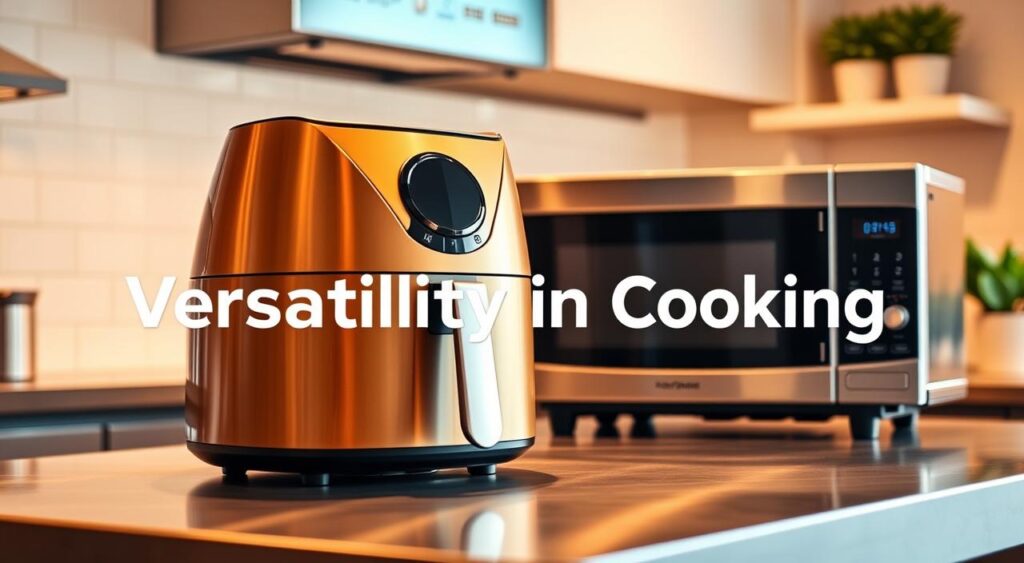
| Cooking Method | Air Fryer | Microwave |
|---|---|---|
| Frying | Yes, with minimal oil | No |
| Baking | Yes | Limited capability |
| Grilling | Yes | No |
| Steaming | No | Yes |
| Reheating | Yes | Yes |
Air fryers and microwaves add unique value to the kitchen. They meet different cooking needs and tastes. Knowing what each can do helps cooks choose the right one for their dishes.
Health Considerations
Many are looking for healthier ways to cook, turning to air fryers and microwaves. Each has its own health benefits and drawbacks. Knowing these is key to choosing the right appliance.
Healthier Cooking with Air Fryers
Air fryers are seen as a healthier choice than deep-frying. They use little to no oil, cutting down on calories. Air frying gives a crispy texture like deep-frying but with less fat. This is great for those wanting to eat less fried food but still enjoy the taste.
Air fryers also let you cook a variety of foods, from veggies to proteins, in a healthier way. They promote healthier cooking methods by needing less oil. This makes them perfect for those watching their health.
Health Effects of Microwave Cooking
Microwave cooking is often misunderstood. When used right, it can be a healthy choice. It cooks food quickly and with little water, keeping nutrients in. But, it’s important to use safe containers to avoid harmful chemicals in food.
One big plus of microwave cooking is it steams veggies without extra water or oil. This keeps their nutrients. But, overcooking or using the wrong containers can ruin these benefits.
| Appliance | Health Benefits | Potential Drawbacks |
|---|---|---|
| Air Fryer | Reduces oil consumption, achieves crispy texture with less fat | May not be as effective for large quantities, some models can be bulky |
| Microwave | Quick cooking retains nutrients, can steam food without added oil | Risk of overcooking, requires microwave-safe containers |
In conclusion, both air fryers and microwaves are healthier cooking options if used right. Knowing their health effects helps people make better choices for their diet.
User Experience and Ease of Use
In the world of kitchen appliances, how easy they are to use matters a lot. Today’s air fryers and microwaves are made to be simple to use. They help users cook their favorite dishes with ease.
Air Fryer Usability
Air fryers are easy to use, thanks to their simple controls and preset settings. Many have digital screens that let users pick cooking options and track progress.
Some key features that make air fryers easy to use include:
- Preset cooking programs for common foods like fries, chicken, and steak
- Adjustable temperature controls for customized cooking
- Timers that allow for precise cooking control
Microwave Usability
Microwaves are also designed to be easy to use, with simple interfaces. Many have sensor cooking, which adjusts cooking time and power based on the food.
Some notable features of microwaves that make them easy to use include:
- One-touch cooking buttons for common tasks like reheating and defrosting
- Multi-stage cooking capabilities that allow for complex cooking sequences
- Child safety locks that prevent accidental starts
To show the differences in user experience between air fryers and microwaves, let’s look at a comparison table:
| Feature | Air Fryer | Microwave |
|---|---|---|
| Primary Cooking Method | Convection cooking with minimal oil | High-frequency electromagnetic waves |
| User Interface | Digital controls with preset options | Simple button interface with sensor cooking |
| Cooking Speed | Generally faster than traditional oven, but slower than microwave | Quick cooking with variable power levels |
Both air fryers and microwaves offer unique experiences. Air fryers give more control over cooking, while microwaves cook food quickly. The choice between them depends on your cooking needs and preferences.
Conclusion: Which is Faster?
Choosing between an air fryer and a microwave often comes down to speed. But, which one cooks faster?
Microwaves usually win when it comes to quick reheating and cooking some foods. But, air fryers give you a crispy texture that microwaves can’t match.
Speed Differences Summary
Air fryers and microwaves cook food at different rates. Microwaves are great for fast reheating. Air fryers, on the other hand, cook food evenly and healthily.
Choosing the Right Appliance
When deciding between an air fryer and a microwave, think about what you need. If you want something fast, a microwave might be best. But, for a crispy, healthier option, choose an air fryer.

